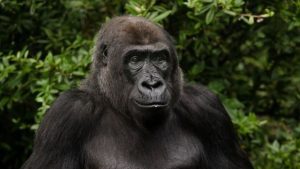 Our World
Our World  Our World
Our World  Pop Culture
Pop Culture 10 Incredible Female Comic Book Artists
 Crime
Crime 10 Terrifying Serial Killers from Centuries Ago
 Technology
Technology 10 Hilariously Over-Engineered Solutions to Simple Problems
 Miscellaneous
Miscellaneous 10 Ironic News Stories Straight out of an Alanis Morissette Song
 Politics
Politics 10 Lesser-Known Far-Right Groups of the 21st Century
 History
History Ten Revealing Facts about Daily Domestic Life in the Old West
 Weird Stuff
Weird Stuff 10 Everyday Products Surprisingly Made by Inmates
 Movies and TV
Movies and TV 10 Actors Dragged out of Retirement for One Key Role
 Creepy
Creepy 10 Lesser-Known Shapeshifter Legends from Around the World
 Our World
Our World 10 Science Facts That Will Change How You Look at the World
 Pop Culture
Pop Culture 10 Incredible Female Comic Book Artists
 Crime
Crime 10 Terrifying Serial Killers from Centuries Ago
Who's Behind Listverse?

Jamie Frater
Head Editor
Jamie founded Listverse due to an insatiable desire to share fascinating, obscure, and bizarre facts. He has been a guest speaker on numerous national radio and television stations and is a five time published author.
More About Us Technology
Technology 10 Hilariously Over-Engineered Solutions to Simple Problems
 Miscellaneous
Miscellaneous 10 Ironic News Stories Straight out of an Alanis Morissette Song
 Politics
Politics 10 Lesser-Known Far-Right Groups of the 21st Century
 History
History Ten Revealing Facts about Daily Domestic Life in the Old West
 Weird Stuff
Weird Stuff 10 Everyday Products Surprisingly Made by Inmates
 Movies and TV
Movies and TV 10 Actors Dragged out of Retirement for One Key Role
 Creepy
Creepy 10 Lesser-Known Shapeshifter Legends from Around the World
10 Weird and Wonderful New Discoveries from the Animal Kingdom
A list here for nature enthusiasts as we delve into the wild world of the animal kingdom. These jaw-dropping discoveries provide a dazzling insight into the diverse and often surprising behaviors of creatures, great and small.
For this list, we journey from the depths of the ocean, where king crabs hitchhike and cuttlefish flex their smarts, to the radioactive boars of southeast Germany, taking in all kinds of oddities in between. Nature never ceases to amaze, and these stories are a testament to the wonders of the animal kingdom.
Related: 10 Amazing Animals That Re-Emerged from Extinction
10 A New Treatment for Gorilla Arthritis

It’s not just us humans that suffer from arthritis. The condition affects all sorts of animals and creatures, and gorillas are no exception. When staff at the Budapest Zoo spotted one of the older females, Liesel, struggling to walk on her left leg, they feared the primate may have succumbed to swelling in her joints.
There is currently no widespread “cure” for arthritis. Once the cartilage begins to break down, it is thought to be damaged beyond repair. But a team of international scientists begs to differ. Working as part of the Stem CellX—a collaboration of international stem cell experts—the researchers are developing a way to reverse the impact of arthritis using mesenchymal stem cells.
In 2023, the team successfully treated Liesel for her arthritis. They used stem cells taken from the fat tissue of a younger gorilla named N’yaounda. Liesel is believed to be the first primate to have their cartilage rebuilt using the Stem CellX technique.[1]
9 The Mysterious Case of Germany’s Radioactive Pigs
The radioactive wild boars of southeast Germany have baffled scientists for years. The pigs were initially contaminated by the lingering radiation from the 1986 Chernobyl nuclear disaster. But decades have passed since then, and the radioactivity levels of other local species have lowered over time. So, why do the boars’ levels remain so high?
This question has stumped researchers for some time now, so much so that they’ve named it the “wild boar paradox.” But in August 2023, a solution was uncovered at long last.
The answer, it turns out, lies in the boars’ diets. Soil analysis revealed remarkably high levels of cesium-137, which impacts many fungi growing in the area. When our porcine pals decide to feast on wild truffles, they ingest dangerously high amounts of radioactive matter.
The American Chemical Society published a paper on the bizarre Bavarian boars, highlighting the ongoing ecological repercussions of nuclear incidents. “This study,” the authors wrote, “illustrates that strategic decisions to conduct atmospheric nuclear tests 60−80 years ago still impact remote natural environments, wildlife, and a human food source today.”[2]
8 Thousands of Octopuses Gather around Inactive Volcano
Ringo Starr once wrote of his desire to live in an octopus’ garden under the sea. Well, now perhaps he can, thanks to a strange occurrence off the coast of California.
Earlier this year, scientists were intrigued to discover swarms of octopuses mysteriously gathered at an underwater hydrothermal spring. While they counted 6,000 so far, the team has only explored a portion of the site. In total, they reckon there could be as many as 20,000.
Researchers speculate that the tentacled creatures are drawn in by the warm waters. The congregation, the largest of its kind ever seen, challenges the idea that octopuses are solitary creatures. Scientists say it adds another layer to our understanding of these cephalopods, who never fail to astonish.[3]
7 Snoozy Penguin Sleeps over 10,00 Times Every Day
Moving on now to the chinstrap penguin that has the art of sleeping down to a T. This charming little seabird is a master when it comes to catching forty winks, napping over 10,000 times a day in tiny bursts. Each snooze lasts an average of four seconds, which adds up to over 11 hours of total daily sleep time.
Chinstrap penguins face the constant threat of danger, especially when nesting. While one parent voyages out to bring back food, often gone for days on end, the other stays back alone and protects the egg. But this is no time for extended slumber. The Antarctic waddlers need to be on high alert to fend off attacks from predatory skua birds, as well as rival penguins who might swoop in and take their materials.[4]
6 Australian Dolphins Spotted Carrying Out a Heist
In what scientists believe is groundbreaking footage, dolphins have been filmed executing a brainy heist to get their fins on some tasty treats. The video shows the marine masterminds working together to steal bait from crab pots. Beneath the waves of Koombana Bay, the dextrous daredevils use their snouts to tear dead fish out of the mesh traps. Dolphins one, crabbers nil.
The footage shows just how cunning and resourceful these aquatic mammals are. It sheds light on the problem-solving skills of two particular troublemakers: Calypso and her calf Reggae. As conservationist Rodney Peterson explains, “Calypso and Reggae. Yeah, if it wasn’t for those two, crabbing would be pretty simple, really.”[5]
5 King Crabs Seen Using Sea Pigs to Hitch a Ride
Scientists from MBARI made an intriguing discovery while exploring the ocean blue. They spotted young king crabs using sea pigs as a sort of marine taxi service, hitching a ride to stay out of sight of predators.
The stowaway scamps can be seen hiding underneath the sea pigs, which drag themselves across the muddy plains of the seafloor. But the deep-sea ditherers don’t seem to mind their travel companions. Researchers studied around 2,600 sea pigs off the coast of California and discovered that almost a quarter were crab carriers.
The discovery offers us an unseen look at the oddities of marine life. It shows how different species can form unlikely alliances to survive the many dangers that lurk beneath the ocean depths.[6]
4 Are Cuttlefish as Clever as Children?
In a recent experiment, a group of cuttlefish proved their surprising cognitive abilities. The underwater critters aced the marshmallow test, throwing up questions about how brainy marine life can be.
The marshmallow test is an experiment devised by Stanford researchers to test children’s thinking and planning skills. A child is given a marshmallow and asked not to eat it. They are told that if they can go 15 minutes without gobbling it, they will be rewarded with a second marshmallow and can eat both.
Researchers from the University of Cambridge adapted the test for cuttlefish using two chambers full of snacks. One contained raw prawn and opened straight away. The other was full of far more enticing live shrimp but only opened after a delay. They could only choose one snack: Take the prawn straight away or wait for the tastier shrimp. Impressively, all the mollusks in the trial opted to wait.
Behavioral ecologist Alexandra Schnell spearheaded the research, which suggests we may have underestimated the marine creatures’ intelligence. “Cuttlefish in the present study were all able to wait for the better reward and tolerated delays for up to 50-130 seconds,” she explained, “which is comparable to what we see in large-brained vertebrates such as chimpanzees, crows, and parrots.”[7]
3 Prehistoric Predator Worm Uncovered in Greenland
A team of scientists in Korea has unearthed evidence of a giant predatory worm that menaced the ancient seas. This newly discovered species, Timorebestia koprii, measured around 12 inches (30 cm) in length. That might not sound enormous today. But by the standards of the ancient oceans, the killer worm was a Goliath. The marine monster lived over 500 million years ago. Fossil records suggest that Timorebestia used its formidable jaws to devour other deep-sea critters and ascend the food chain.
Researchers are thrilled with their discovery, which sheds light on Earth’s prehistoric ecosystems. They uncovered thirteen Timorebestia fossils in North Greenland, some of the oldest of their kind that scientists have ever found. The ancient oceans harbored a breadth of strange and wonderful life forms. This newly found species adds a captivating chapter to our understanding of marine evolution.[8]
2 Birds and Humans Hunt Honey Together in Mozambique
Sometimes, life can be a bit better when you do things as a pair. In Mozambique, locals are teaming up with a species of bird known as the greater honeyguide. Together, the unusual duo track down and break open beehives, excavating the delicious treats that lie inside. Hunters from the Yao tribe harvest the honey, whereas the birds chow down on a snack of wax and beetle larvae.
Research shows that the birds and humans have developed a unique bond, with the honeyguides learning to recognize the calls of local tribespeople. As California-based anthropologist Brian Wood explained, “The benefits of the honey-hunter-honeyguide relationship should produce long-lasting, ‘sticky’ traditions.” It goes to show the incredible connections that can occur, sometimes between the most unlikely of partners, when they team up for a common goal.[9]
1 Wrens Teach their Chicks to Sing While Still in the Egg
Wrens are amazing creatures. Now, thanks to a recent study, scientists in Australia have found a remarkable new fact: wrens teach their chicks to sing before they’ve hatched. When the young birds emerge from their shells, they sing a similar tune to one their mother sang to them as eggs.
This surprising behavior unveils the songbirds’ astonishing communication skills. What’s more, experts have found this maternal musical bond across multiple species of wren, including the splendid fairywren, the purple-crowned fairywren, and the thick-billed grasswren. This suggests that the practice may have begun millions of years ago with a common ancestor.
Scientists are unsure why wrens have developed this brilliant musical ability, but they have some hunches. One theory is that it stops nest infiltration by cuckoos. Cuckoos are sneaky creatures who lay their eggs in other birds’ nests to fool other mothers into raising their children. But the shorter incubation means young cuckoos won’t have had time to learn the songs. Others believe it has something to do with sexual selection—mothers teaching their offspring to sing to help them woo a mate when they’re older.
Whatever the reason behind their prenatal serenading, it’s a fascinating insight into the world of nature and early education.[10]








